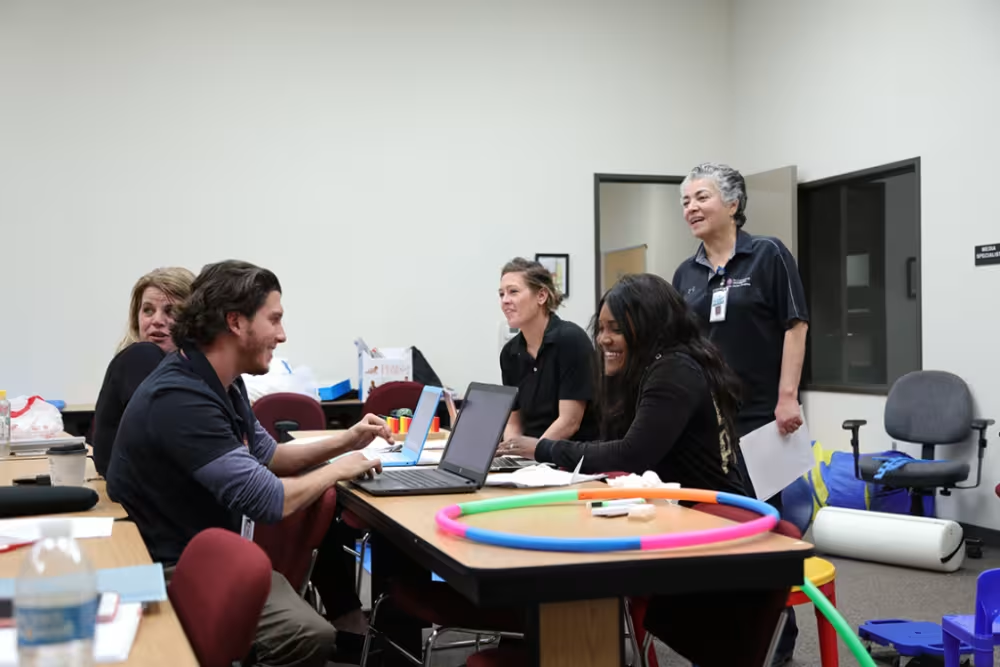Occupational Therapist Assistant Degree and Requirements
Each blog post is dated and contains accurate information as of that date. Certain information may have changed since the blog post’s publication date. If you would like to confirm the current accuracy of blog information, please visit our online OTA overview page or contact admissions at (877) 233-2677.
An OTA works under an occupational therapist to assist in rehabilitating patients with an illness, injury or disability impeding their daily life. To become an OTA, students must complete their associate degree at an accredited university and pass the NBCOT exam to receive licenses.

Across the globe, millions of people struggle to complete daily tasks due to illness or injury. Occupational therapists and their assistants work to get these people back to their prior level of function. If you’re looking for meaningful work that directly impacts people’s lives, consider becoming an occupational therapy assistant (OTA).
At St. Catherine University, our occupational therapy assistant program combines online coursework and in-person skills labs to give students a well-rounded education, preparing them for the challenges of working as an occupational therapy assistant.
If an OTA’s exciting and rewarding work appeals to you, let’s learn more about what it means to be an OTA, what kind of education is required, and how to earn an occupational therapist assistant degree.
What is an Occupational Therapy Assistant?
Occupational Therapy Assistants work directly with individuals experiencing limitations in their ability to perform their daily activities.
An occupational therapy assistant works directly under the supervision of an occupational therapist, aiding patients and assisting them throughout their treatment plan. Beyond progressing patients through their recovery programs, the duties of an occupational therapy assistant include:
- Showing patients and caregivers alternative ways to perform daily activities and correctly use medical equipment or devices.
- Working with patients to overcome setbacks using problem-solving techniques and consulting the supervising occupational therapist.
- Taking notes on the patient’s condition, updating daily progress, and amending the patient’s record with other applicable information.
- Providing continuous updates to the occupational therapist or treatment team so they can modify the therapy plan accordingly.
- Ensuring patients understand their treatment plan and answering any questions they may have.
Where Do Occupational Therapy Assistants Work?
The work of an occupational therapy assistant can take them to many places:
- Hospice care facilities.
- Mental health facilities.
- Public and private schools.
- Correctional facilities.
- Local, state, and private hospitals.
- Long-term and skilled nursing facilities.
- Outpatient clinics.
- Inpatient rehabilitation Centers.
Both full-time and part-time positions exist in the field of Occupational Therapy. Because patients’ needs and schedules differ, OTA work may require early morning, evening, or weekend hours.
OTA Degree Requirements

The first step to becoming an occupational therapy assistant is enrolling in an occupational therapy assistant degree program. Prospective students need at least a high school diploma to be eligible for an OTA associate degree.
Most students enter the program at St. Kate’s as pre-OTA students. Students must complete prerequisite coursework and most of their liberal arts and science core requirements before beginning OTA program courses.
To be admitted as a pre-OTA student, you must meet the minimum requirements:
- A high school diploma or passing GED exam score
- A minimum cumulative high school GPA of 2.5, or
- Completed college credits with a minimum cumulative GPA of 2.5
Once you’ve met these requirements and all prerequisite courses, you’ll complete a robust OTA curriculum that includes the following components.
OTA Coursework
As part of your OTA coursework, you will be taught how specific disease processes affect an individual’s ability to perform daily tasks and create treatment plans to support those individuals.
OTA Labs

You’ll put theory into practice during skills labs, where students receive personalized instruction and immediate feedback. At St. Kate’s, our skills labs have a 12:1 student-to-instructor ratio to ensure everyone gets the attention and instruction they need. Our program is designed to cover the six core areas of occupation therapy, including:
- Children and youth.
- Mental health.
- Productive aging.
- Rehabilitation and disability.
- Work and industry.
- Health and wellness.
OTA Fieldwork
The last segment of your OTA schooling is the fieldwork portion of the curriculum. Fieldwork is essential for developing the skills to become an entry-level OTA practitioner. Throughout the two eight-week fieldwork sessions, students will get direct contact with patients in hospitals, nursing homes, outpatient centers, mental health facilities, etc. They can build the necessary experience and connections to bolster their careers post-graduation.

Still trying to figure out what an OTA does? Experience a day in the life of an occupational therapist.
OTA License, Certification, and Registration
OTA graduates must pass the National Board for Certification in Occupational Therapy (NBCOT) exam to meet the occupational therapist assistant requirements. Once they have received a passing grade on the NBCOT exam, they can apply for licensure in the state where they wish to practice as an OTA.
Important Skills
Working in the occupational therapy field requires specific skills, licensure, and certification. These skills are helpful for many career paths, but to succeed as an OTA, the following are especially beneficial.
Sociability
Occupational therapy assistants (OTAs) work hands-on with patients daily and must communicate effectively and professionally with patients and their families.
Versatility
OTAs must be attentive to the efficacy of the current therapy program throughout a patient’s treatment. If the treatment plan isn’t showing results, OTAs must adapt and problem-solve to find a solution that best meets the patient’s goals.
Empathy
Patients typically seek occupational therapy to improve a physical limitation impeding their daily life, which can lead to frustration if progress doesn’t come immediately. During this time, patience and compassion are essential to support patients.

Attention to Detail
OTAs collect specific patient data and must be adept at understanding the important details in medical charts and assessments.
Physical Endurance
As OTAs physically assist patients with their treatments, they require the strength to bend, kneel, lift, and stand to guide them through movements such as teaching and physically performing transfers of a patient.
OTA Career Outlook
The occupational therapy field requires a lot of energy from its OTAs, mentally and physically, but it also has much to give. Beyond the emotionally rewarding aspects of occupational therapy, OTAs enjoy many financial benefits and advancement opportunities.
According to the Bureau of Labor Statistics, the average salary of an OTA is $65,450 per year, and the occupational therapy assistant field is projected to grow 23% from 2022 to 2032, much faster than average.
This growth is most likely due to an expected increase in the elderly population needing services like occupational therapy. Over time, this increase in demand may increase the average OTA salary.
Uncertain about becoming an OTA? Discover 6 reasons why the OTA career outlook is bright.

Advancement Opportunities in Occupational Therapy
Occupational therapy assistants looking to grow in their careers have plenty of opportunities for advancement. With training, they can pursue advanced specializations, each with specific required coursework, a minimum number of hours practicing as an OTA, and a certification exam to meet the designated qualifications. Let’s look at some of the certifications OTAs may obtain.
Assistive Technology Professional (ATP)
An ATP certification provides training and designates expertise in applying appropriate assistive technology to occupational therapy practice. To become an ATP, candidates must complete the required education and at least two years of practice in employing assistive technology directly with patients.
Certified Stroke Rehabilitation Specialist (CSRS)
The CSRS certification qualifies practitioners to utilize neurorehabilitation recovery strategies, specifically for treating stroke patients. To become a certified stroke rehabilitation specialist, practitioners must complete a seminar course and receive a passing grade of 80% or higher on the certification examination. Certification renewal is required every two years to ensure the material stays fresh.
Certified Lymphedema Therapist (CLT)

CLTs work with patients with lymphedema or other related disorders to assess, plan, and provide therapeutic interventions to maximize function and mobility. Lymphedema is a lymphatic disorder that creates a system blockage in the lymph nodes, typically resulting in the swelling of an arm or leg.
To receive a CLT certification, candidates must finish a Complete Decongestive Therapy course, possess professional state licensing, meet a minimum 12-hour college credit science requirement, and achieve a passing score on the CLT-LANA exam.
Certified Aging in Place Specialist (CAPS)
CAPS professionals strategize and implement solutions to ensure their senior clients can remain safe and comfortable in their current homes as their mobility declines with age. Multiple programs are available to receive a CAPS certification, but as a standard, candidates must complete the prescribed curriculum, submit their graduation application, and renew their certification annually.
Certified Kinesio Taping Practitioner (CKTP)
A Certified Kinesio Taping Practitioner specializes in the therapeutic taping technique, kinesio taping, which alleviates pain and encourages lymphatic drainage by microscopically lifting the skin. Understanding how and where to apply the tape to achieve optimal results and promote healing requires training and mastery.
To attain this certification, candidates must be students working toward their OTA licensing, complete the approved seminars, pass the CKTP exam with a grade of 80% or higher, and maintain KTAI membership.

Interested in learning more about OTA specialties? Explore the top 10 occupational therapy specialties.
Take the First Step Towards Earning an OTA Degree
Occupational therapy assistants have a meaningful and far-reaching impact on the lives they touch. With St Kate’s three start dates each year, you can begin practicing as an OTA in as few as 16 months.
Contact an admissions advisor today to learn more about our program and jumpstart your new career.


